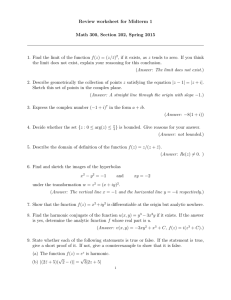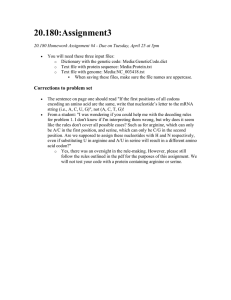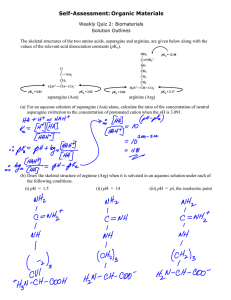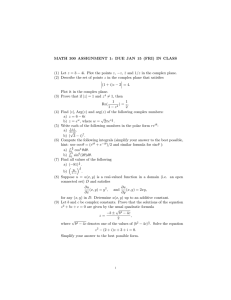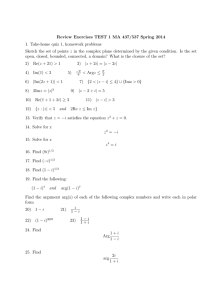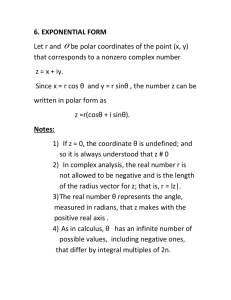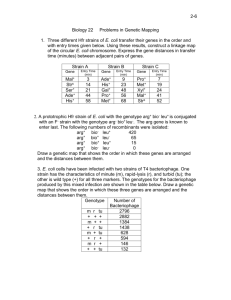Document 14093943
advertisement
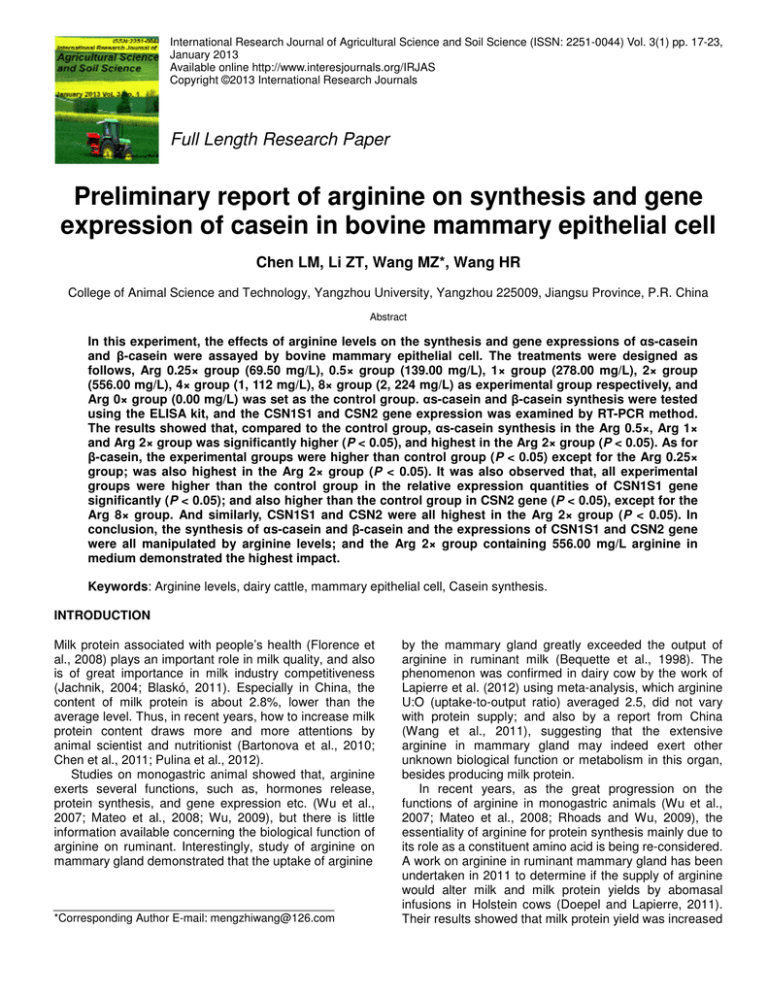
International Research Journal of Agricultural Science and Soil Science (ISSN: 2251-0044) Vol. 3(1) pp. 17-23, January 2013 Available online http://www.interesjournals.org/IRJAS Copyright ©2013 International Research Journals Full Length Research Paper Preliminary report of arginine on synthesis and gene expression of casein in bovine mammary epithelial cell Chen LM, Li ZT, Wang MZ*, Wang HR College of Animal Science and Technology, Yangzhou University, Yangzhou 225009, Jiangsu Province, P.R. China Abstract In this experiment, the effects of arginine levels on the synthesis and gene expressions of αs-casein and β-casein were assayed by bovine mammary epithelial cell. The treatments were designed as follows, Arg 0.25× group (69.50 mg/L), 0.5× group (139.00 mg/L), 1× group (278.00 mg/L), 2× group (556.00 mg/L), 4× group (1, 112 mg/L), 8× group (2, 224 mg/L) as experimental group respectively, and Arg 0× group (0.00 mg/L) was set as the control group. αs-casein and β-casein synthesis were tested using the ELISA kit, and the CSN1S1 and CSN2 gene expression was examined by RT-PCR method. The results showed that, compared to the control group, αs-casein synthesis in the Arg 0.5×, Arg 1× and Arg 2× group was significantly higher (P < 0.05), and highest in the Arg 2× group (P < 0.05). As for β-casein, the experimental groups were higher than control group (P < 0.05) except for the Arg 0.25× group; was also highest in the Arg 2× group (P < 0.05). It was also observed that, all experimental groups were higher than the control group in the relative expression quantities of CSN1S1 gene significantly (P < 0.05); and also higher than the control group in CSN2 gene (P < 0.05), except for the Arg 8× group. And similarly, CSN1S1 and CSN2 were all highest in the Arg 2× group (P < 0.05). In conclusion, the synthesis of αs-casein and β-casein and the expressions of CSN1S1 and CSN2 gene were all manipulated by arginine levels; and the Arg 2× group containing 556.00 mg/L arginine in medium demonstrated the highest impact. Keywords: Arginine levels, dairy cattle, mammary epithelial cell, Casein synthesis. INTRODUCTION Milk protein associated with people’s health (Florence et al., 2008) plays an important role in milk quality, and also is of great importance in milk industry competitiveness (Jachnik, 2004; Blaskó, 2011). Especially in China, the content of milk protein is about 2.8%, lower than the average level. Thus, in recent years, how to increase milk protein content draws more and more attentions by animal scientist and nutritionist (Bartonova et al., 2010; Chen et al., 2011; Pulina et al., 2012). Studies on monogastric animal showed that, arginine exerts several functions, such as, hormones release, protein synthesis, and gene expression etc. (Wu et al., 2007; Mateo et al., 2008; Wu, 2009), but there is little information available concerning the biological function of arginine on ruminant. Interestingly, study of arginine on mammary gland demonstrated that the uptake of arginine *Corresponding Author E-mail: mengzhiwang@126.com by the mammary gland greatly exceeded the output of arginine in ruminant milk (Bequette et al., 1998). The phenomenon was confirmed in dairy cow by the work of Lapierre et al. (2012) using meta-analysis, which arginine U:O (uptake-to-output ratio) averaged 2.5, did not vary with protein supply; and also by a report from China (Wang et al., 2011), suggesting that the extensive arginine in mammary gland may indeed exert other unknown biological function or metabolism in this organ, besides producing milk protein. In recent years, as the great progression on the functions of arginine in monogastric animals (Wu et al., 2007; Mateo et al., 2008; Rhoads and Wu, 2009), the essentiality of arginine for protein synthesis mainly due to its role as a constituent amino acid is being re-considered. A work on arginine in ruminant mammary gland has been undertaken in 2011 to determine if the supply of arginine would alter milk and milk protein yields by abomasal infusions in Holstein cows (Doepel and Lapierre, 2011). Their results showed that milk protein yield was increased 18 Int. Res. J. Agric. Sci. Soil Sci. Table 1. Composition of amino acids in the basic arginine-removal medium* (mg/L) Items L-Glycine L-Alanine L-Arginine L-Aspartic acid L-Cysteine L-Glutamic acid L-glutamine L-Histidine L-Isoleucine L-Leucine L-Lysine L-Methionine L-Phenylalanine L-Proline L-Serine L-Threonine L-Tryptophan L-Tyrosine L-Valine Concentration 18.75 4.45 0.00 6.65 17.56 7.35 365.00 31.48 54.47 59.05 91.25 17.24 35.48 17.25 26.25 53.45 9.02 55.79 52.85 *Prepared according to the DMEM/F12 medium (Catalog # 11320082, Gibco, Invitrogen, Life Technologies Corporation, US), which the original arginine concentration was 147.50 mg/L. by infusion of Arginine compared with the control. Despite this novel result, the real function and its mechanism of arginine in this organ of ruminant are still not very clear. We hypothesized that arginine might regulate the casein synthesis of dairy cattle. The present work was carried out in this purpose to verify if arginine might manipulate milk casein yields by the in vitro culture of mammary epithelial cell at different arginine levels. MATERIALS AND METHODS Technologies Corporation, US) supplemented with the antibiotic-antimycotic mix. Mammary tissue slices were prepared within 30 min of slaughter. Tissue incubations and the purification of mammary epithelial cell Incubations were initiated by addition of tissue slices, and performed in 25-mL polypropylene flasks placed in an incubator at 37 °C. The collagenase digestion method was introduced to purify epithelial cell. The tissue culture and the mammary epithelial cell identification were carried out according to the methods described by Wu (1996), O'Quinn et al. (2002) and Xu et al. (2012). Animals and mammary tissue sampling This study was approved by the Inner Mongolia Agricultural University Animal Care and Use Committee. The multiparous dairy cattle were obtained from the Experimental Farm of Inner Mongolia Aricultural University. Immediately before exsanguination, suckled mammary glands were split down the mid-line, and mammary tissue was excised from the center portion of four glands. Obvious pieces of connective tissue and fat were removed. Mammary tissue was cut into small pieces (0.5 mm in thickness) using curved scissors and placed in oxygenated (95% O2/5% CO2) DMEM/F12 medium (Gibco, Invitrogen, Catalog # 11320082, Life Preparation of arginine-removal DMEM/F12 medium As arginine exists in the ordinary commercial cell medium, medium without arginine were prepared by ourselves in our lab. We prepared the basic medium devoid of arginine by combining the individual reagents according to the composition of DMEM/F12 (Gibco, Invitrogen, Catalog # 11320082, Life Technologies Corporation, US) in ultrapure water. For the experimental treatments the arginine was added into the medium in accordance with the experimental design described below. Table 1 shows the arginine and other amino acid profiles in the basic Chen et al. 19 Table 2. Arginine levels in the medium for the in vitro culture of mammary epithelial cell from dairy cattle (mg/L) Items Concentration Arg 0× 0.00 Arg 0.25× 69.50 Arg 0.5× 139.00 medium used in this work. Arg 1× 278.00 Arg 2× 556.00 Arg 4× 1, 112 Arg 8× 2, 224 materials use. The examination steps in detail were carried out as the manufacturer's protocol. Experimental design and treatments RNA Extraction from the mammary epithelial cell The single factorial experimental design was carried out by varying the arginine levels in this work. The media containing arginine that resembled casein the most was defined as Arg 1×. The other treatment groups were made by only varying the arginine concentration, without changing the concentration of the other amino acids. The treatments included 7 groups shown in table 2, respectively was, Arg 0.25× group (arginine at 69.50 mg/L), 0.5× group (arginine at 139.00 mg/L), 1× group (arginine at 278.00 mg/L), 2× group (arginine at 556.00 mg/L), 4× group (arginine at 1, 112 mg/L), 8× group (arginine at 2, 224 mg/L) as experimental groups, and Arg 0× group (arginine at 0.00 mg/L) was set as the control group. Treatments were run in triplicate, and a set of appropriate blank (without cell incubation) was included. The total protein extraction from the mammary epithelial cell After culture for 24 hours with arginine at different levels the reactions were stopped by removing the medium and collecting the cells. The total cellular protein was extracted using lysis solution for immunoprecipitation purchased from Tiandz. Inc. (Catalog. 80807A-50, Tiandz. Inc. Beijing, P. R. china). The main steps were: 1) Removing the cell culture medium, and washed the cell twice by using pre-cool PBS. 2) Added 100 µL cell lysates and then placed on the ice for 10~30 min. 3) Isolated and collected the supernatant by centrifugation at 15, 000 g for 10 min at 4 °C, and then placed on the ice and intended to be examined. The steps in detail were conducted as described in the production manual. The measurement of αs- and β- casein synthesis The synthesis of αs- and β- casein was measured by the bovine α-casein and β-casein ELISA (Enzyme-linked immunosorbent assay) kits divided by Yanhui Com. (Shanghai, China) from R&D System (R&D Systems, Minneapolis, MN, USA). The principle of ELISA based on the principle of antibody-antibody interaction; this test allows for easy visualization of results and can be completed without the additional concern of radioactive After culture for 24 hours with arginine at different levels the reactions were stopped by removing the medium and collecting the cells. Cells were then frozen in liquid nitrogen prior to storage at -80 °C. The RNA was extracted and purified using a cellular RNA extraction kit (DP430 spin column kit, Tiangen Biotech, Beijing, China) from the frozen cell described above. The extraction steps were carried out following the manufacturer's protocol. RNA quantity and integrity were confirmed with a NanoDrop 1000 spectrophotometer (NanoDrop Technologies, Wilmington, DE, US). The examination of target gene expression RNA was reverse-transcribed using PrimeScript® 1st Strand cDNA Synthesis Kit (TaKaRa Code: D6110A, TaKaRa Biotechnology (Dalian) Co., Ltd., Dalian, China), according to the manufacturer’s instructions. The RT-PCR TM was performed using SYBR Premix Ex Taq kit (TaKaRa Code: DRR081A, TaKaRa Biotechnology (Dalian) Co., Ltd., Dalian, China) in a Bio-Rad IQ5 Real-Time PCR (Bio-Rad Laboratories, Inc. Hercules, CA, US). The glyceraldehyde-3-phosphate dehydrogenase (GAPDH) was used as internal reference gene, and the primers information used were shown in table 3. Statistical analysis Results were manipulated in Excel 2003, and statistical analysis was carried out by ANOVA test with posthoc multiple comparison test of Duncan using SAS9.0 (SAS; SAS Inst., Cary, NC, USA). P values less than 0.05 were declared to be significant (P < 0.05). RESULTS The synthesis of αs-casein and β-casein The ELISA standard curves of αs-casein and β-casein presented in figure 1 (A for αs-casein and B for β-casein respectively) were created using standard samples 20 Int. Res. J. Agric. Sci. Soil Sci. Table 3. The Information of Real Time PCR primers of target genes detected in mammary epithelial cell from dairy cattle by in vitro culture with different arginine levels Items CSN1S1 CSN2 Sequences of primers (5’ – 3’) Genebank ID Production Annealing temperature F: AAT CCA TGC CCA ACA GAA AG R: TCA GAG CCA ATG GGA TTA GG BC109618 189 bp 59 °C NM_181008 115 bp 55 °C XM_001252479 177 bp 59 °C F: GTG AGG AAC AGC AGC AAA CA R: CCA GGA GCA AAA CCA AGA AC F: GGG TCA TCA TCT CTG CAC CT GAPDH R: GGT CAT AAG TCC CTC CAC GA A: αs-casein B: β-casein ug/mL ug/mL Figure 1. A - ELISA standard curve for αs-casein, B - ELISA standard curve for β-casein. Standards curves were created using standard samples provided by the kits (R&D Systems, Minneapolis, MN, USA), with OD value as y-coordinate and the concentration of the standard as x-coordinate. provided by the kits, with OD value as y-coordinate and the concentration of the standard as x-coordinate. It was obvious that, R-squared of the two curves were all higher than 0.99 and indicated that the linear equations could be used to determine the concentration of casein in samples. According to the linear equation derived from the standard curves, the quantities of αs-casein and β-casein were calculated and presented in figure 2 (A for αs-casein and B for β-casein respectively). From figure 2 (A), obviously, the synthesis of αs-casein in the Arg 2× group (containing 556.00 mg/L arginine in the medium) was highest among groups (P < 0.05), and significantly higher than that in the control group (P < 0.05) and the other experimental groups (P < 0.05). It was further observed that, as the increasing of arginine concentrations, the αs-casein upgraded from the Arg 0× group to the Arg 2× group; but downgraded from the Arg 2× group to the Arg 8× group. In addition, the other experimental groups such as the Arg 0.5× group and the Arg 1× group were significantly higher than the control group (P < 0.05), but not the Arg 0.25× group, Arg 4× group, and Arg 8× group (P > 0.05). From figure 2 (B), β-casein obviously had a similar change manner to the αs-casein with the arginine concentrations increasing, and likewise, was highest in the Arg 2× group (containing 556.00 mg/L arginine in the medium) which was significantly higher than the other groups (P < 0.05), including the control group. Additionally, the other experimental groups were also significantly higher than the control group (P < 0.05) in β-casein synthesis, except for the Arg 0.25× group (P > 0.05). The expression of CSN1S1 and CSN2 gene The results of the relative expression quantities of CSN1S1 and CSN2 gene displayed in figure 3 (A for CSN1S1 gene and B for CSN2 gene respectively). Figure 3 showed that, the relative expression quantities of both 2 genes in the Arg 2× group (containing 556.00 mg/L arginine in the medium) were all highest (P < 0.05) amongst groups, and significantly higher than those of the Chen et al. A: αs-casein concentration (mg/mL) 4.50 (mg/mL) B: β-casein concentration a 5.73 6.00 4.00 3.49 3.50 5.00 2.93 3.00 4.00 3.00 3.41 2.60 21 2.73 c b 3.49 de 2.00 f 2.00 c 2.28 ef c 2.27 bc 2.81 2.50 2.50 c b cd b 2.38 a 1.78 1.50 2.00 1.00 1.00 0.50 Groups 0.00 Arg 0× Arg 0.25× Arg 0.5× Arg 1× Arg 2× Arg 4× Groups 0.00 Arg 0× Arg 8× Arg 0.25× Arg 0.5× Arg 1× Arg 2× Arg 4× Arg 8× Figure 2. Effects of arginine levels on casein synthesis in bovine mammary epithelial cell in vitro. There: A for αs-casein, B for β-casein respectively. Arg 0× (control without supplemental Arg; 0.00 mg/L), Arg 1× (to match its concentration in casein; 278.00 mg/L), Arg 0.25× (deficiency in casein; 69.50 mg/L), Arg 0.5× (deficiency in casein; 139.00 mg/L), Arg 2× (excess in casein, 556.00 mg/L), Arg 4× (excess in casein, 1,112 mg/L), and Arg 8× (excess in casein, 2,224 mg/L). The columns with the same letters meant no difference between groups (P > 0.05), while with different letters meant differences (P < 0.05). 3.50 A: CSN1S1 gene B: CSN2 gene 4.00 a 3.54 a 2.75 3.00 3.50 b 2.47 b 2.26 2.50 3.00 c 1.83 1.82 2.00 1.50 b 2.25 2.50 2-∆∆Ct 2-∆∆Ct c d 1.24 1.83 d 1.39 1.50 e 1.00 bc c 1.86 2.00 d 1.21 de 1.00 1.00 1.00 0.50 0.50 Groups Groups 0.00 0.00 Arg 0× Arg 0.25× Arg 0.5× Arg 1× Arg 2× Arg 4× Arg 8× Arg 0× Arg 0.25× Arg 0.5× Arg 1× Arg 2× Arg 4× Arg 8× Figure 3. Effects of arginine level on the expressions of casein genes in bovine mammary epithelial cell in vitro. There: A for CSN1S1 gene, B for CSN2 gene, respectively. Arg 0× (control without supplemental Arg; 0.00 mg/L), Arg 1× (to match its concentration in casein; 278.00 mg/L), Arg 0.25× (deficiency in casein; 69.50 mg/L), Arg 0.5× (deficiency in casein; 139.00 mg/L), Arg 2× (excess in casein, 556.00 mg/L), Arg 4× (excess in casein, 1,112 mg/L), and Arg 8× (excess in casein, 2,224 mg/L). The columns with the same letters meant no difference between groups (P > 0.05), while with different letters meant differences (P < 0.05). other groups including the control (P < 0.05) and the other experimental groups (P < 0.05). Furthermore, the other experimental groups were all significantly higher than the control group (P < 0.05) in CSN1S1 gene expression; and the other experimental groups were also significantly higher than the control group (P < 0.05) in CSN2 gene expression, except for the Arg 8× group (P > 0.05). Additionally, the relative expression quantities of both 2 genes increased from the Arg 0× group to the Arg 2× group; while decreased from the Arg 2× group to the Arg 8× group, as the increase of arginine concentrations. DISCUSSIONS In present work, the synthesis of αs-casein and β-casein 22 Int. Res. J. Agric. Sci. Soil Sci. increased by 120% and 96% in response to Arg 2× compared with Arg 0×, by 110% and 75% compared with 0.25×; by 68% and 40% compared with 0.5×, by 64% and 19% compared with Arg 1×, by 141% and 24% compared with 4×, and by 152% and 53% compared with 8×. The current results indicated that, arginine promoted the casein synthesis in a dose-dependent manner. In the low concentration range up to 556.00 mg/L arginine in medium, the synthesis of casein increased along with the increasing of arginine concentration, but however decreased with the continuously increasing of arginine concentration in medium. This result indicated there was an optimal concentration for the highest yield in casein. The highly probable reasons could be that, (1) as its role in protein deposition, a specific concentration of arginine in medium might promote the casein synthesis in mammary epithelial cell in vitro, it was however that, much more high concentration of arginine in medium might limit the casein synthesis. Raggio et al. (2004) also suggested that, the efficiency of transfer of absorbed amino acids into milk protein decreased markedly as protein supply increased. (2) previous study showed that, some special amino acids such as arginine, cysteine, glutamine, leucine, were not only the precursor regulators of protein but also the regulators of gene expression Wu (2009). For an example, based on their results, Bauchart-Thevret et al. (2010) considered that arginine-dependent cell survival and protein synthesis signaling in IPEC-J2 cells (A porcine IEC line originally derived from the jejunal crypts of a neonatal piglet) were mediated by mTOR. Based on the present result, we speculated that the arginine might regulate the casein synthesis through some unknown ways, like stimulating the corresponding gene expression, which in turn encouraged the casein synthesis. In this case, we further checked the casein gene expression and discussed below. Study by Tan et al. (2010) showed that, arginine supplementation stimulated protein synthesis and reduced protein degradation in LPStreated IPEC-1 cells probably; And the arginine deprivation decreases cell proliferation and heat shock protein expression and enhances the susceptibility to apoptosis, and most changes induced by arginine deficiency were restored by subsequent supplementation with arginine or citrulline in preconfluent Caco-2 cells (Lenaerts et al., 2007). And several recent studies also suggested that arginine may directly activated anabolic cellular signaling pathways (Corl et al., 2008; Yao et al., 2008; Tan et al., 2010). As we know, any step of protein expression may be modulated by the bioactive compounds, from the DNA-RNA transcription step to post-translational modification of a protein, including Chromatin domains, Transcription, Post-transcriptional modification, RNA transport, Translation initiation, mRNA degradation. And the most extensively utilized point is Transcription (Livingstone et al., 2010; Khositseth et al., 2011; Schwanhäusser et al., 2011). How is arginine on casein synthesis in bovine mammary epithelial cell? In this work, the Arg 2× group which culture containing 556.00 mg/L arginine demonstrated the highest relative expression quantities of CSN1S1 and CSN2 gene. Our results indicated that, arginine did exert a regulating effect on CSN1S1 and CSN2 gene expression, with an optimal promoting concentration for the highest expression. Interestingly, the synthesis of αs-casein and β-casein were also highest in the same group, as described above. These result indicated that, arginine affected translation control points to regulate protein synthesis in bovine mammary epithelial cell in vitro, which agreed with the work previously published in 2011 (Appuhamy et al.), showed that the essential amino acid availability affected translation initiation and elongation control points to strongly regulate protein synthesis in MAC-T cells and in mammary gland tissue. Additionally, another in vitro study of amino acids on casein genes expressions from dairy cattle (Yang et al., 2007) also showed that, the expression of casein αs1-gene was enhanced with increasing addition levels of methionine from 0 µg/mL to 60 µg/mL and then decreased thereafter. And similarly, Li (2011) concluded that, the expression of CSN1S1, CSN1S2, CSN2, CSN3 and LALBA in bovine mammary epithelial cells all increased by the adding of 1.2 mmol/L lysine and 0.5 mmol/L methionine in medium. Those results above provide impetus for increased focus on functional amino acid regulation in casein synthesis control in mammary epithelial cells from dairy cattle. However, the present results can only provide some basic information for the function of arginine on casein synthesis in mammary epithelial cell from dairy cattle, more reaches are needed to better clarify the regulating rule and it’s mechanism in the future. CONCLUSION Results of this study demonstrate for the first time that arginine plays an important role in the synthesis of casein in bovine mammary epithelial cells. Arginine supplementation did stimulate αs-casein and β-casein synthesis, with the Arg 2× group which containing 556.00 mg/L arginine in the medium demonstrating the highest effects. Our results can provide some basic information for the further study of clarifying the regulating role and regulating mechanism of arginine on casein synthesis in dairy cattle mammary gland. ACKNOWLEDGEMENTS This work was supported by Innovation Foundation for Undergraduate of Yangzhou University (2012JSSPITP1373); the Open Research Fund Projects of the State Key Laboratory of Animal Nutrition (2004DA125184F1106); National Basic Research Chen et al. Program of China (973 Program: 2011CB100803), and the Advantageous Disciplines of Jiangsu Province P.R. China. The authors would like to give special thanks to Inner Mongolia Agricultural University for the experimental animal and Dr. Xu B.L. for the help in this work. REFERENCES Appuhamy JADRN, Bell AL, Nayananjalie WAD, Escobar J, Hanigan MD (2011). Essential Amino Acids Regulate Both Initiation and Elongation of mRNA Translation Independent of Insulin in MAC-T Cells and Bovine Mammary Tissue Slices. J. Nutri. 141, 1209-1215. Bartonova P, Vrtkova I, Kaplanova K, Urban T (2012). Association between CSN3 and BCO2 gene polymorphisms and milk performance traits in the Czech Fleckvieh cattle breed. Genet Mol Res. 11, 1058-1063. Bauchart-Thevret C, Cui L, Wu GYBurrin DG (2010). Arginine-induced stimulation of protein synthesis and survival in IPEC-J2 cells is mediated by mTOR but not nitric oxide. Am. J. Physiol. Endocrinol. Metab. 299, E899-E909. Bequette BJ, Backwell FRC, Crompton LA (1998). Current Concepts of Amino Acid and Protein Metabolism in the Mammary Gland of the Lactating Ruminant. J. Dairy Sci. 81, 2540-2559. Blaskó B (2011). World Importance and Present Tendencies of Dairy Sector. Applied Studies in Agribusiness and Commerce – APSTRACT Agroinform Publishing House, Budapest, Pp. 119-123. Chen B, Wang C, Wang YM, Liu JX (2011). Effect of biotin on milk performance of dairy cattle: a meta-analysis. J. Dairy Sci. 94, 3537-3546. Corl BA, Odle J, Niu X, Moeser AJ, Gatlin LA, Phillips OT, Blikslager AT, Rhoads JM (2008). Arginine activates intestinal p70S6K and protein synthesis in piglet rotavirus enteritis. J. Nutr. 138, 24-29. Doepel L, Lapierre H (2011). Deletion of arginine from an abomasal infusion of amino acids does not decrease milk protein yield in Holstein cows. J Dairy Sci. 94, 864-873. Florence M, Asbridge M, Veugelers PJ (2008). Diet quality and academic performance. J. Sch. Health 78, 209-215. Jachnik P (2004). Regionalization vs. Globalization of the World Dairy Economy: Conflict or Complementarity? Advances in Dairy Technology 16, 93-99. Khositseth S, Pisitkun T, Slentz DH, Wang G, Hoffert JD, Knepper MA, Yu MJ (2011). Quantitative protein and mRNA profiling shows selective post-transcriptional control of protein expression by vasopressin in kidney cells. Mol. Cell Proteomics. 10(1): M110.004036. Epub 2010 Oct 12. Lapierre H, Lobley GE, Doepel L, Raggio G, Rulquin H, Lemosquet S (2012). Triennial Lactation Symposium: Mammary metabolism of amino acids in dairy cows. J. Anim. Sci. 90, 1708-1721. (Abstract) Lenaerts K, Renes J, Bouwman FG., Noben JP, Robben J, Smit E, Mariman EC (2007). Arginine deficiency in preconfluent intestinal Caco-2 cells modulates expression of proteins involved in proliferation, apoptosis, and heat shock response. Proteomics 7, 565-577. Li XY (2011). The Ratio between Lysine and Methionine on Casein Synthesis in Bovine Mammary Epithelial Cells [D]. Chinese Academy of Agricultural Sciences, Beijing. http://www.agrpaper.com/the-ratio-between-lysine-and-methionine-on-c asein-synthesis-in-bovine-mammary-epithelial-cells.htm (in Chinese with English abstract) 23 Livingstone M, Atas E, Meller A, Sonenberg N (2010). Mechanisms governing the control of mRNA translation. Phys Biol., 7(2):021001. (Abstract) Mateo RD, Wu G, Moon HK, Carroll JA, Kim SW (2008). Effects of dietary arginine supplementation during gestation and lactation on the performance of lactating primiparous SOWS and nursing piglets. J. Anim. Sci. 86, 827-835. O'Quinn PR, Knabe DA, Wu G (2002). Arginine catabolism in lactating porcine mammary tissue. J Anim. Sci. 80, 467-474. Pulina G, Nudda A, Battacone G, Dimauro C, Mazzette A, Bomboi G, Floris B (2012). Effects of short-term feed restriction on milk yield and composition, and hormone and metabolite profiles in mid-lactation Sarda dairy sheep with different body condition score. Italian J. Anim. Sci. 11(2). DOI: 10.4081/ijas.2012.e28 Raggio G, Pacheco D, Berthiaume R, Lobley GE, Pellerin D, Allard G, Dubreuil P, Lapierre H (2004). Effect of level of metabolizable protein on splanchnic flux of amino acids in lactating dairy cows. J. Dairy Sci. 87, 3461-3472. Rhoads JM, Wu G (2009). Glutamine, arginine, and leucine signaling in the intestine. Amino Acids 7, 111-122. Schwanhäusser B, Busse D, Li N, Dittmar G, Schuchhardt J, Wolf J, Chen W, Selbach M (2011). Global quantification of mammalian gene expression control. Nature 473, 337-342. (Abstract) Tan B, Yin Y, Kong X, Li P, Li X, Gao H, Li X, Huang R, Wu G (2010). L-Arginine stimulates proliferation and prevents endotoxin-induced death of intestinal cells. Amino Acids 38, 1227-1235. Wang Q, Ao CJ, Ga ED, Lu DX, Gao M, Duan B, Feng ZQ (2011). Influence of Infusing Amino Acids into the External Pudendal Artery on Nutrient Uptake in the Mammary Gland of Dairy Goats. China Agriculture Science 44, 4481-4487. (in Chinese with English abstract) http://211.155.251.135:81/Jwk_zgnykx/CN/10.3864/j.issn.0578-1752. 2011.21.017 Wu G (1996). An important role for pentose cycle in the synthesis of citrulline and proline from glutamine in porcine enterocytes. Arch. Biochem. Biophys. 336, 224-230. Wu G, Bazer FW, Davis TA, Jaeger LA, Johnson GA, Kim SW, Knabe DA, Meininger CJ, Spencer TE, Yin YL (2007). Important roles for the arginine family of amino acids in swine nutrition and production. Livest. Sci. 112, 8-22. Wu GY (2009). Amino acids: metabolism, functions, and nutrition. Amino Acids 37, 1-17. Xu BL, Wang MZ, Zhang XF, Ha S, Wang CY, Ao CJ, Wang HR (2012). Arginine Levels Affect Growth and CSN3 Gene Expression of Dairy Cows Mammary Epithelial Cells in Vitro. Chinese Journal of Animal Nutrition 24, 852-858. (in Chinese with English abstract) http://118.145.16.228/Jweb_dwyy/CN/10.3969/j.issn.1006-267x.2012. 05.009 Yang JY, Wu YM, Liu JX (2007). Effects of Methionine and Methionylmethionine on Expression of Casein α_(s1) Gene in Cultured Bovine Mammary Epithelial Cells. Journal of Agricultural Biotechnology 1, 24-27. (in Chinese with English abstract) http://en.cnki.com.cn/Article_en/CJFDTOTAL-NYSB200701005.htm Yao K, Yin YL, Chu W, Liu Z, Deng D, Li T, Huang R, Zhang J, Tan B, Wang W, Wu G (2008). Dietary arginine supplementation increases mTOR signaling activity in skeletal muscle of neonatal pigs. J. Nutr. 138, 867-872.
